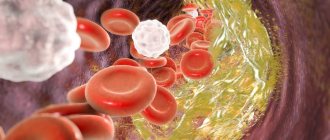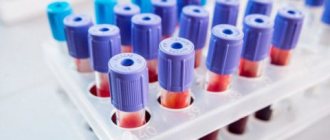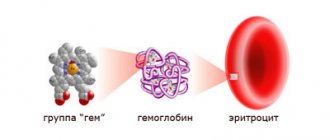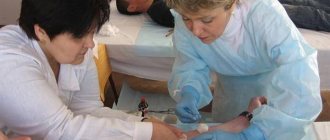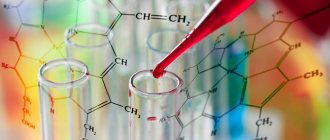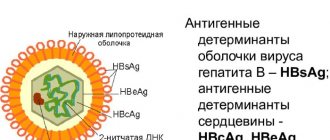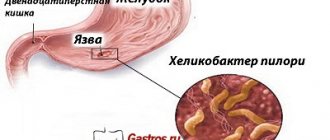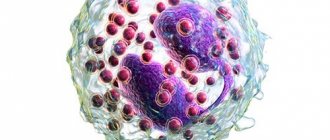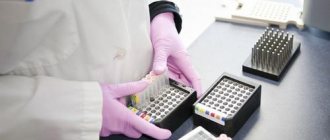- Systemic atherosclerosis;
- Thrombosis of the main arteries;
- Cardiac angina;
- Ischemia of the cardiac organ;
- Coronary insufficiency;
- Myocardial infarction and stroke.
For most people, the norm for very low molecular density lipoproteins (VLDL) is from 0.260 mmol/liter to 1.40 mmol/liter.
If, according to the results of the lipogram, the indicator of LDL cholesterol molecules is within the normal range or slightly reduced, then there is no need to adjust the metabolic lipid processes in the body.
If a patient has very low molecular density lipoproteins ranging from 0.030 mmol/liter to 0.450 mmol/liter, this means there is a high risk of developing pathologies of the heart organ and blood flow system.
VLDL - what is it?
This is a class of molecules that refers to complex molecular compounds.
The composition of the VLDL molecule includes:
- Free triglyceride molecules;
- Saturated fatty acids;
- Neutral lipids;
- Phospholipid molecules;
- Cholesterol molecules.
The content of components in the VLDL molecule has different percentages. Lipoproteins are the main transporters of cholesterol molecules to all cells of the body.
All lipoprotein molecules in the human body are divided into fractions and are divided into good cholesterol and bad cholesterol.
Very low density cholesterol fraction
Possible consequences and prognosis
The prognosis for lipoprotein levels will depend on what provoked the pathological condition and the extent of the deviation from the norm.
If treatment is not started on time or there are no results from the prescribed therapy, serious complications may develop.
For example, with advanced atherosclerosis, a complete blockage of the vessel occurs with the resulting plaque. This can cause hypoxia of the organ to which the affected vessel leads.
There are also cases of tissue death, which, in the absence of emergency treatment, can lead to irreparable consequences.
Functions of lipoprotein fractions
Lipids perform important actions in the human body:
- Cholesterol molecules are found in all membrane membranes of cells in the human body;
- With the help of lipids, membranes obtain their firmness and elasticity;
- Lipids help in the production of bile acids;
- Lipids synthesize vitamin E, A and vitamin D;
- Lipids increase immunity and delay the penetration of harmful toxins into the membrane;
- Lipids are involved in the production of sex hormones by adrenal cells;
- Protects nerve fibers from the external environment with a dense and elastic sheath;
- Lipids are found in the cerebrospinal fluid and connect the brain and spinal cord cells.
Lipoproteins are the main transporters of lipids throughout the body.
Lipids themselves are insoluble in liquid, so to perform their functional duties, they need to bind to protein compounds.
The main protein compound for lipids is apoprotein. Lipids with apoproins form lipoproteins of varying molecular densities. The density of a molecule depends on the amount of apoprotein protein in it.
All lipoproteins transport fat molecules throughout the body and perform their functions and differ in density and size:
| Name of lipoprotein | Cholesterol Molecule Size | Composition of a lipoprotein molecule | Characteristics of lipoprotein molecules |
| Chylomicron molecules (CM) | 0.5 nm - 1.2 nm | Contains: | · formation occurs in the small intestine, through absorption by the intestinal walls from food that enters the body; |
| · triglycerides of exogenous type (85.0%); | · chylomicrons, entering the blood, quickly bind to protein compounds; | ||
| · cholesterol molecules; | · the function of chylomicron molecules is the transport of cholesterol molecules from the intestine to liver cells; | ||
| cholesteryl ester. | · Chylomicrons in capillary and venous blood are not diagnosed in a blood test using biochemistry. | ||
| Very low density lipoproteins (VLDL) | 30.0 nm to 80.0 nm | Contains: | Functionality of VLDL molecules: |
| endogenous triglycerides; | · these are transporters of cholesterol, which is synthesized in liver cells, as well as in other tissues of the body; | ||
| · phospholipid molecules; | · triglycerides in the VLDL molecule, this is an energy source for the body; | ||
| · cholesterol ester. | · triglycerides may exhibit properties of settling on the endothelium of arteries. Together with lipids, triglycerides form a cholesterol plaque. | ||
| Low-density lipoproteins (LDL) | 18.0 nm to 26.0 nm | Contains: | · the formation of the LDL molecule occurs by lipolysis, when triglycerides are detached from the VLDL molecule; |
| · cholesterol molecules; | · properties of LDL are the transport of the endogenous type of cholesterol to peripheral organs. | ||
| · lipid ester; | |||
| · phospholipid molecules; | |||
| · minimal composition of apoprotein. | |||
| High-density lipoprotein molecules called good cholesterol (HDL) | 8.0 nm to 11.0 nm | Contains: | Features of the HDL molecule: |
| apolipoprotein A1; | · the main collector of free cholesterol in the bloodstream and transporter of these molecules into liver cells for their disposal using bile; | ||
| apolipoprotein A2; | · cleanses the bloodstream of cholesterol deposits of LDL and VLDL molecules. | ||
| · phospholipid molecules. |
Norms for men and women
Metabolic processes in female and male bodies proceed differently. That is why in medicine there are pathologies that are considered “male” or “female”. Young women are very rarely diagnosed with atherosclerosis. This is due to the active production of the hormone estrogen - it reliably protects a woman’s blood vessels from accumulations of harmful cholesterol. The male hormone is not able to protect blood vessels, so you need to get tested more often, reducing cholesterol levels if they are elevated.
With age, estrogen production decreases, and after menopause it stops altogether. Therefore, after 40-45 years, both men and women are equally at risk of developing any diseases of the cardiovascular system and related complications.
Indicators will vary not only depending on the gender, but also the age of the patient. The content of very low-density and low-density lipoproteins is assessed. The first is a mixture of fats and proteins, shaped like a sphere. They contain predominantly cholesterol and are the main provocateurs of atherosclerosis. If there are too many of them, cholesterol plaques begin to form on the walls of blood vessels. Here are the standards established for the content of this substance:
- Age up to 19 years - for men from 1.54 to 3.60 mmol/liter, for women from 1.54 to 3.87 mmol/liter.
- From 20 to 30 years - for men from 1.52 to 4.49 mmol/liter and for women from 1.54 to 4.12 mmol/liter.
- From 31 to 40 years - for men from 2.09 to 4.91 mmol/liter and for women from 1.84 to 4.35 mmol/liter.
- From 41 to 50 years - for men from 2.30 to 5.32 mmol/liter, for women from 2.04 to 4.90 mmol/liter.
- From 51 to 60 years - for men from 2.31 to 5.30 mmol/liter and for women from 2.30 to 5.64 mmol/liter.
- From 61 to 70 years - for men from 2.31 to 5.56 mmol/liter and for women from 2.44 to 5.54 mmol/liter.
Analysis for VLDL concentration
It is mandatory for such categories of people to undergo analysis for cholesterol and fractionally.
A cholesterol test is taken as a preventative measure, during the period of treatment and diet, and also with the help of a lipogram, an accurate diagnosis of pathologies of the heart organ and blood flow system can be established:
- For the prevention of systemic atherosclerosis, in men after the 35th birthday, in women after the 45th birthday;
- If total cholesterol is elevated, then it is necessary to make a lipid spectrum, which reflects lipoprotein fractions;
- Patients at risk of developing heart diseases and vascular pathologies with a history of myocardial infarction, cerebral stroke, systemic atherosclerosis;
- For hypertension with very high rates;
- If you have type 1 or type 2 diabetes mellitus;
- If the patient develops the pathology of obesity (in women, the waist circumference is greater than 80.0 centimeters, and in men, 94.0 centimeters);
- If there is a disturbance in lipid metabolism, which leads to hypercholesterolemia;
- For IHD pathology, the patient undergoes biochemistry with a lipid profile once every 6 months;
- Post-infarction and post-stroke period;
- With aortic aneurysm, with atherosclerosis of the lower extremities;
- For atherosclerosis of the coronary vessels, as well as the arteries of the neck and head;
- For oncological tumors in internal organs;
- A month after the anti-cholesterol diet;
- 2 weeks after starting medication treatment.
If a patient develops the pathology of obesity, it is necessary to get tested
Preparing for analysis
To establish fractionally cholesterol, as well as triglycerides, the body needs to be prepared as follows:
- Blood is donated in the morning - no later than 10 - 11 o'clock;
- Do not eat for 10 - 11 hours before donating blood;
- It is prohibited not to eat for more than 12 hours, because the body’s supply of triglycerides decreases, which will be shown by an incorrect analysis of the LDL and TG molecules, which together make up VLDL;
- 2 weeks before donating blood - do not drink alcohol;
- 2 - 3 hours before the procedure - do not smoke;
- In the morning you can drink no more than 150 grams of water;
- Taking medications can distort the lipogram and show a reduced index of cholesterol fractions, so you need to inform your doctor about taking medications;
- It is not advisable for women to donate blood during menstruation, because the results in the lipogram may be distorted;
- A week before donating blood, stop sports training;
- You need to donate blood without being nervous or tense;
- After suffering an infectious pathology, blood can be donated only after 1.5 - 2 months;
- You can also donate blood for a lipogram 1.5 months after the birth.
Get tested for the concentration of VLDL molecules in the blood plasma
Normal in the body
If there are significant or minor deviations from the norm in the molecules of the VLDL fraction in the body, then this is a sign of the development of serious pathologies in the body.
If VLDL is increased in the plasma blood, then the composition of the blood changes significantly, which can even be seen visually - the blood is cloudy and has a white tint.
It is the VLDL fraction that most influences the increase in the cholesterol index in the blood plasma.
According to WHO standards, the normal VLDL fraction in human blood is as follows:
- The norm for men is 0.780 mmol/liter - 1.810 mmol/liter;
- The normal Vldl index for women is 0.780 mmol/liter - 2.20 mmol/liter.
This is what the main lipoproteins look like
Interpretation of analyzes
As a rule, a laboratory form consists of several columns, each of which contains certain information about the state of the blood. Since the VLDL test is taken with a general lipid profile, a person will be able to find out the level of total and useful cholesterol.
Norma HS
In addition to the patient’s indicators, there will definitely be a separate column with boundary values so that you can determine how much the results of this test differ from normal age values.
The norm for VLDL (reference values) is considered to be: 0.25-1.05 mmol/l.
VLDL is elevated - what does this mean?
An increased VLDL fraction index means the presence of external and internal causes of increased lipoproteins in the body.
External provoking factors include:
- Poor nutrition, when a lot of fatty foods are consumed, as well as foods that are prepared by frying;
- Nicotine addiction - when smoking, the integrity of the endothelium is disrupted, which contributes to the growth of atherosclerotic deposits;
- Alcohol addiction in the chronic stage - with alcoholism, a disorder occurs in the liver cells, which disrupts the correct synthesis of lipids and increases the LDL and VLDL fractions;
- Low human activity and complete lack of physical activity - with such deviations in lifestyle, disturbances occur in the metabolic processes of fat and carbohydrates in the body, which contributes to an increase in the VLDL fraction;
- A long process of unhealthy fasting leads to the accumulation of triglycerides and cholesterol molecules in the body, which contributes to an increase in the VLDL fraction.
- The period during which a woman carries a baby;
- Postpartum period in a woman.
These are pathologies that can be corrected and the VLDL index will return to normal.
cholesterol
is increased for internal reasons in the body:
- Genetic hereditary dyslipoproteinemia;
- Hypercholesterolemia of hereditary genetic nature;
- Age-related changes - in men after their 45th birthday, in women after their 50th birthday;
- Hypertension in both sexes;
- Overweight - obesity;
- Diabetes mellitus type 1 and 2;
- Surgical correction of arteries in the blood flow system;
- Constant mental and emotional stress;
- Pathologies of liver cells - liver cirrhosis, hepatosis of liver cells;
- Diseases in the gallbladder - cholecystitis of gallbladder cells;
- Pathologies in the endocrine organs - the thyroid gland, the adrenal glands;
- Oncological neoplasms in the prostate gland;
- Pancreatic oncology;
- Pathology pancreatitis;
- Severe pathologies in the renal organ;
Cholesterol and LP, role in the body and norms
Causes and types of deviations
Changes in the level of lipoproteins of this type in the blood cause both diseases of internal organs and special conditions of the body.
Promotion
Very low and low density lipoproteins are most often elevated for the following reasons:
Pancreatic tumor.- Cholestasis.
- Chronic renal failure.
- Hypothyroidism.
- Prostate tumor.
- Nephrotic syndrome.
However, in addition to pathological conditions, the causes of the disorder may be a hereditary predisposition, an individual characteristic of the body, or a diet that includes too many fat-containing foods. Often these reasons occur all together.
Decline
VLDL is very rarely reduced and its decrease is not as diagnostically important as its increase. But still, this deviation may indicate the following diseases:
- Lack of folic acid.
- Oncology of the hematopoietic system.
- Large area burns.
- Infection in the acute phase.
- Vitamin B12 deficiency.
- Liver diseases.
- COPD – chronic obstructive pulmonary diseases.
- Hypothyroidism.
Reasons for the downgrade
A reduced index of the VLDL cholesterol fraction also has a bad effect on the human body and can lead to the development of severe pathologies.
The etiology of the fall in the VLDL fraction index is as follows:
- Genetic hereditary hyperlipoproteinemia;
- Inflammation in the patient’s joint apparatus;
- Oncological malignant neoplasms in bone marrow cells;
- Acute infectious invasion of agents into the body;
- Blood pathology - megaloblastic anemia;
- Burns of the skin over a large area;
- Bronchitis of an obstructive nature;
- Pathology tuberculosis.
To normalize the VLDL lipid fraction and restore the balance of fat metabolism in the body, drug and non-drug treatment is used.
Chylomicrons
Alpha and beta cholesterol - what is it?
In a biochemical analysis of the lipid spectrum of the blood composition, total cholesterol is isolated, as well as the components of the cholesterol molecule - alpha lipoproteins, as well as beta lipoproteins.
Alpha lipoproteins are high molecular weight HDL cholesterol.
Beta lipoproteins are low molecular weight LDL cholesterol, as well as VLDL.
Cholesterol molecules are transporters of nutrients in the bloodstream; the higher the molecular weight of the lipoprotein, the better it copes with the work of transporting nutritional components through the main vessels of the bloodstream.
HDL, in addition to transporting nutrients to the tissues of the body, collects excess fat in the main arteries and delivers it to the liver cells, where they are utilized with the help of bile acid.
If the cholesterol molecule contains a sufficient amount of HDL, then it fully copes with the task of cleaning the blood vessels from excess lipids.
If the molecule is oversaturated with beta lipids, then it loses its transporter abilities and is deposited on the main arteries, causing the development of the pathology atherosclerosis.
The more beta lipoproteins in a cholesterol molecule, the more dangerous it becomes for the vascular system.
Beta lipoproteins cause pathological disorders in the heart organ, in liver cells, in the kidney organ, in the brain vessels, in various parts of the arteries of the bloodstream system.
Uncontrolled levels of good and bad cholesterol in the blood can lead to the development of serious pathologies in the body, which can cause death.
Restoring the index with diet
To reduce the increased VLDL index, diet therapy is selected individually, but the basis of the diet is table No. 10.
The general essence of this anti-cholesterol diet:
- Consume plenty of fresh vegetables, garden herbs and fruits, as well as vegetable oils that are rich in polyunsaturated acids;
- Meat should be low-calorie and with a minimum of animal fat - this is rabbit, young veal, turkey and chicken. It is forbidden to eat meat - pork, fatty beef, lamb, poultry - duck and goose meat;
- Fermented milk products should be low-fat, and you can also eat cheeses with a low percentage of fat. It is forbidden to eat cream, sour cream and processed cheese with high fat content;
- Introduce sea fish into your diet, which is rich in omega-3 and nuts with polyunsaturated acids;
- Avoid sweets and starchy foods. Fatty and sweet desserts should be replaced with fruit soufflé and ice cream, but only without added sugar;
- Meals should be at least 5 - 6 times a day;
- Every day the menu should include porridge - oatmeal, buckwheat, pearl barley;
- Do not eat fried foods, as well as canned fish and meat, smoked foods;
- Avoid eating lard and industrially produced sauces - mayonnaise;
- Do not consume foods with trans fats - margarine, fast food;
- Avoid drinks containing alcohol;
- Limit the use of sugar and salt in food.
Products for restoring the VLDL index
Lipoproteins: norm for diagnosis and treatment methods for deviations
In diabetes mellitus, it is important to control not only glucose levels, but also the concentration of lipoproteins in the blood. You can determine the atherogenicity coefficient, identify the amount of lipoproteins and their ratio by fraction, and also find out the level of triglycerides and cholesterol using a lipid profile.
Diagnostics
A lipoprotein test is performed by drawing blood from a vein. Before the procedure, the patient should not eat for twelve hours. One day before the test, you should not drink alcohol, and it is not recommended to smoke an hour before the test. After collecting the material, it is examined using the enzymatic method, in which the samples are stained with special reagents. This technique allows you to accurately determine the quantity and quality of lipoproteins, which allows the doctor to correctly assess the risk of developing vascular atherosclerosis.
How to reduce lipoprotein levels?
If, according to the diagnostic results, increased fractions of VLDL and LDL are noted, then it is necessary to use drug treatment, which is aimed at inhibiting HMG-CoA reductase in liver cells to prevent excessive synthesis of low-density lipoproteins.
The following medications are used in therapy:
- A group of statins that reduce the synthesis of cholesterol molecules by liver cells, and also relieve inflammation in the arterial endothelium in the bloodstream, and have properties to destroy lipid molecules - these are the drugs Rosuvastatin, Atorvastatin, as well as Lovastatin, the drug Zocor and Crestor;
- Antiplatelet agents that can thin the blood plasma are the drug Aspirin;
- Vasodilator medications to normalize blood flow, which helps increase blood speed in the main lines and reduce low-density cholesterol - the drug Trental;
- The group of fibrates - reduce the production of LDL and TG molecules, which increases the synthesis of high molecular density lipids. The drug Fenofibrate is used for treatment;
- Bile acid sequestrants are drugs that reduce the synthesis of lipoprotein molecules and promote catabolism and the removal of VLDL outside the body - the drug Colestipol, the medication Cholestyramine and Cholestan;
- Vitamin B, C and E.
Why does the level increase?
A similar phenomenon is not uncommon in the test results of people whose age exceeds 40-50 years. How can it be explained, what factors influence changes in the content of these substances in human blood?
- Stagnation of bile in the liver or bile ducts in pathologies such as hepatitis, cirrhosis, cholecystitis, tumors of various natures.
- Renal dysfunction leading to renal failure.
- Diseases of the endocrine system, in particular hypothyroidism.
- Uncompensated diabetes mellitus.
- Metabolic disorders, obesity.
- Alcohol abuse.
- Oncological diseases of the pancreas or prostate gland.
- Unbalanced diet with a predominance of fatty foods.
Beta lipoproteins are deposited on the walls of blood vessels gradually. Therefore, for a long time a person may not have any complaints at all.
But when their concentration becomes too high, the first symptoms of atherosclerosis begin to appear:
- with rare exceptions, weight gain;
- the appearance of wen on the body and face. These are small seals under the skin, filled with cholesterol, they are localized along the lines of the tendons. In medicine, such formations are called xanthomas and xanthelases;
- aching pain behind the sternum is a symptom of developing coronary heart disease and angina pectoris. Unpleasant sensations can radiate to the neck, shoulder, arms, and at first they can be easily relieved if you take nitroglycerin preparations. But as the disease progresses, pain becomes more frequent, attacks become longer and are poorly suppressed by medications;
- forgetfulness, absent-mindedness, decreased performance;
- numbness of the lower extremities, changes in gait - this indicates that damage to the vessels responsible for the blood supply to the legs occurs.
Norms for lipogram
In order to determine the presence of cholesterol in the body and identify lipoproteins by fraction, you need to make a lipogram.
In accordance with the standard lipogram indicators:
- The normal B index of lipoproteins of the LDL fraction and the VLDL fraction (together) is 2.60 mmol per 1 liter of blood. If the lipid B index is elevated, then there is a great danger of disruption of the functioning of the blood supply system to all organs in the human body, and disturbances in the structure and performance of the cardiac organ,
- The standard high-density lipoprotein index in the female body should be no higher than 1.290 mmol per 1 liter of biological fluid; for the male body these units are slightly higher than the HDL norm of 1.360 mmol/l.
It is also necessary to take into account the ratio between high molecular weight lipoproteins and low density lipids.
If the lipogram results show that low molecular weight cholesterol is almost 3 times higher than high density lipoproteins, then in this case it is necessary to consult a doctor and begin therapy to reduce low molecular weight cholesterol.
According to the standard, the difference between HDL and beta lipids should be no more than 2 times.
Decoding biochemistry for cholesterol
The level of cholesterol in the blood is divided according to the following indicators:
- The cholesterol index in women and the indicator in the male body are different,
- The indicators are affected by the age of the patient; cholesterol is higher in older men and the fairer sex,
- Women are 4 times less likely to suffer from increased cholesterol in the blood, only during menopause the chances of accumulation of atherosclerotic lipid plaques are comparable.
The normal levels of lipoproteins in the female body range from 1.90 mmol per 1 liter of blood to 4.60 mmol per liter.
According to medical experts, the presence of up to 5.0 mmol per liter of cholesterol in the blood is an acceptable level, at which there is no threat of lipid accumulation on the membranes of the main arteries of the vascular system.
According to international indicators, the norm of total cholesterol in the blood is up to 60.0 mmol/l, and does not pose a danger to the heart organ, as well as to the bloodstream system.
Norm for men by age
If the indicator is about 50.0 units. mmol/l, both in men and women, it is necessary to begin treatment, because there is a threat of the appearance of prebetalipoproteins in the molecules.
Women, just like men, need to systematically donate blood for biochemical analysis of cholesterol and do a lipid profile as part of preventive measures.
Norm for women by age
In lipoproteins the norm is in units
1 Blood contains up to 100 different protein components; * using electrophoresis on paper, 5 fractions are isolated, * in agar gel - 7-8, * in starch gel - 16-18, * using immunoelectrophoresis - about 30 fractions.
1 Examine strictly on an empty stomach. 2 The value is related to age.
1 The method is nonspecific; in addition to glucose, other reducing (reducing) substances are determined: glutathione, creatinine, uric acid, ascorbic acid, glucuronic acid, etc. 2 It does not have complete specificity, since, in addition to glucose, galactose, xylose, dextran, hexose interact with orthotoluidine , pentose, disaccharides, glucuronic acid. They overestimate the high levels of hemoglobin, bilirubin, and protein in the blood. 3 The most specific method, however, ascorbic acid and the tetracycline antibiotic must be discontinued within 3 days.
1 In women it is 10% lower than in men; during pregnancy it decreases by 30%.
Functions in the body
Beta lipids, like alpha lipids, are the main transport carriers of cholesterol throughout the body, which saturates organ cells with nutritional components.
B-lipoproteins are actively involved in the transport of carotenoids through the bloodstream, as well as triglycerides and vitamin E.
There is a difference in the structure of high molecular weight and low molecular weight lipoproteins.
Low molecular weight B-lipids, dissolving in the blood plasma, precipitate, which settles in the form of a fatty spot on the inside of the vascular membranes.
If alpha lipids predominate in the blood, then they remove the sediment, and no changes occur in the bloodstream; with an increased level of LDL, the sediment forms a cholesterol plaque, which subsequently becomes the cause of the development of vascular pathology atherosclerosis.
